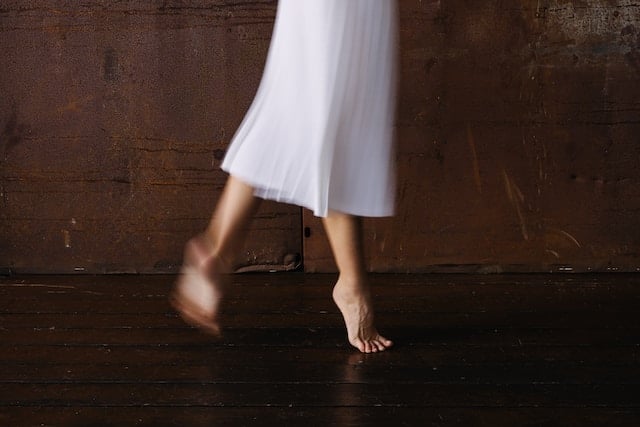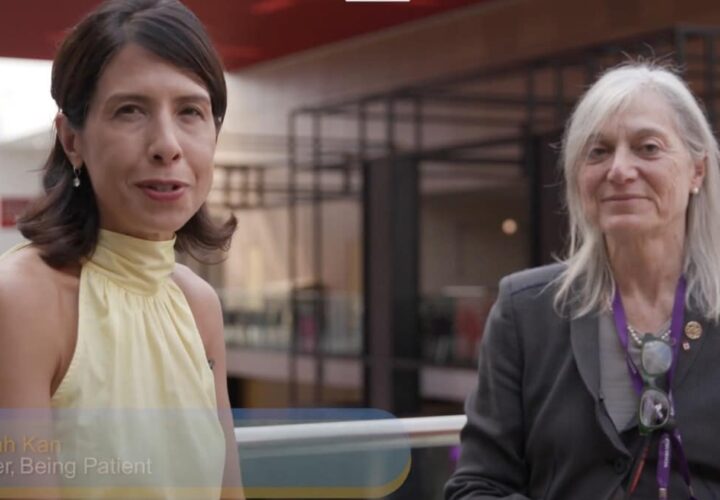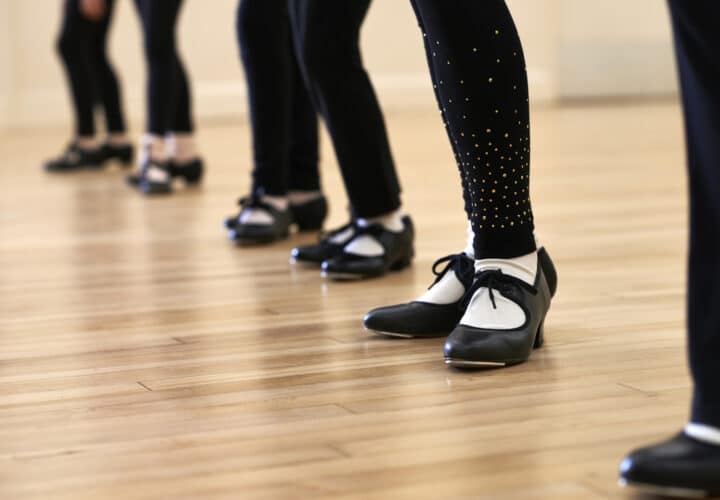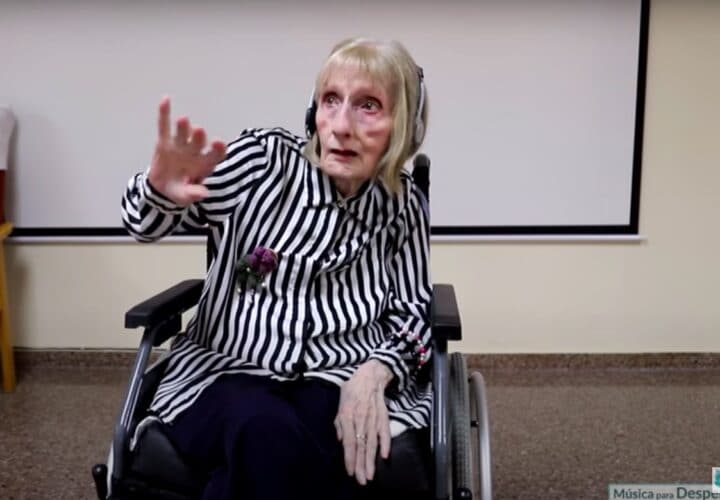Award-winning dance artist and "creative aging" thought leader Magda Kaczmarska discusses how aging adults can benefit from dance and movement — and shares the research underway to better understand the link between dance and brain health.
Studies show that various kinds of physical activity an benefit people living with Alzheimer’s and related dementias — and so can music. Yet, there’s limited research on what dance can do for brain health. While some learning becomes difficult with dementia, some people living with Alzheimer’s have learned new creative skills. This link between creativity, exercise, and music is why leaders in “creative aging,” like Magda Kaczmarska, call for more research in dance and embodied movement.
As an award-winning researcher with a dual background in neuropharmacology research and dance, Kaczmarska focuses on how collective dance and creativity can support brain health. She founded DanceStream Projects, a New York City-based collective whose mission is to “spark brain health and build creative community through dance and movement.”
In 2020, she was awarded an Atlantic Fellowship for Equity in Brain Health from the Global Brain Health Institute (GBHI) to support collaborations around the globe to design and expand access to creative aging programs. With a pilot program grant from the GBHI, she’ll build on her Stories in the Moment program with Dementia Action Alliance to conduct a research study on the impacts of co-creative dance practice for people living with dementia and their caregivers, which is enrolling now.
Kaczmarska joins Being Patient EIC Deborah Kan to share her insights on the benefits of dance for people living with dementia and what future research on embodied movement is needed.
Read the conversation or watch the whole interview below.
Being Patient: Tell us a little bit about your background. How did you get interested in brain research?
Magda Kaczmarska: Thank you for that question. I’ll try to keep it short because there’s a lot. I started off working in research, so my background is in biochemistry and molecular biophysics. I worked for about 10 years in neuropharmacology research, studying Parkinson’s and new treatments for Parkinson’s disease and aging, bone cancer. So, kind of the neuroscience of what happens in bones in different conditions.
I’m also a dancer. I’ve been dancing since I was a child. While I was working in research, I actually learned about this creative aging approach, this idea that we can use art. Especially for me, what was interesting is, you can use dance as a form of not just extending health and well-being for people who are living with a neurodegenerative condition, like Parkinson’s disease or dementia, but that we can also use that as a vehicle for meaning-making to support community. So, I went back and got my MFA in dance, and I’ve been doing this work ever since.
Being Patient: I was so excited about doing this talk because I’ve discovered through interviewing people with dementia that learning continues to flourish in a different way. We have interviewed people who didn’t know they had artistic talent and then unleashed it post-diagnosis. It proves that your creative side can grow, even after a diagnosis. Tell us a little about what we know about the creative brain and why neurodegenerative diseases don’t impact that creative part of the brain as severely as other parts.
Kaczmarska: I love this topic. I just wanted to mention your conversation brings to mind one of my mentors, Dr. Bruce Miller, from the Global Brain Health Institute and the University of California, San Francisco. He’s put this conversation on the map, so I feel the need to honor that. This is an excellent question.
I think the simplest way to put it is that our brains are plastic, are malleable. They’re not static set-in-stone objects that develop when [we’re in our] childhood and maybe our adolescence and then just stay there or go downhill. Now, our brains are constantly evolving across our entire life, and what we do or don’t do changes them. We see that in physical activity and creative activity, we can support different domains of our brain health. I like thinking about that. It’s a much more positive way of thinking about our brain. Same as we can think about heart health or physical health, there are things that we can do to support our brain health, and we do see that engaging in dance helps support different domains of that.
Being Patient: I’ve often heard that dancing is one of the best things you can do for your brain because you’re listening to music while moving. That challenges you to think in new patterns, dance patterns. What do we know about that connection? Why is that so good for our brains?
Kaczmarska: Dance is, as you put it, a really special experience because it’s at once an art form, and also a physical activity. It’s a form of exercise. So, there’s been a lot of research done on [it], but I would say not enough. There’s some research done on what happens as we age in our brains when we engage in dance and kind of coming back to that idea of different domains, we can see that dance supports our cognition.
“Now, our brains are constantly evolving
across our entire life, and what we
do — or don’t do — changes them.”
Thinking about the structure, how different parts of our brain, how much mass there is in different parts of our brain are the different connections in our brain, as well as the function of our brain. How we feel that we’re able to engage in using our brains, that cognition part gets affected, obviously, mobility, and mobility is affected by our brain, right? So, we see that dance supports that, and also our emotional, our social sense of how we perceive our connections with other people and also how we feel our mood changes.
All three of those are impacted by dance in a positive way, from what we see. A lot of that research has been done in healthy older adults, so not people who are living with dementia or another neurodegenerative condition. We need more research there, but we see that a lot of that applies because brains, our brains, we all have them, but, there’s definitely more that we can learn
Being Patient: What part of the brain are we using when we dance? I mean, we know that Alzheimer’s, for example, impacts the hippocampus at first and continues to move to different parts of the brain. But what’s happening in the brain when we dance?
Kaczmarska: Excellent question. I think again, there’s more that we could know. What’s wonderful about dance is that it is using global, we’re using different parts of our brain to support those different spaces. For instance, there’s some research that’s been looking at cognition, thinking about the structures as well as the functions of how our brain works.
We see that with healthy older adults when they engage in an aerobic dance. So, something that gets our heart rate up. This is a group from Rutgers University, Dr. Gluckstein, in New Jersey. They saw that older adults who engage in aerobic dance had more active circuits in the medial temporal lobes, and that’s actually part of the brain that helps us encode and retain memory. That’s one way that we see changes in the structure and the function. One of the other things that we know is that aerobic engagement, that increase of oxygen, is part of the trick, which is one of the reasons why physical activity is so good for us.
“Dance is not just like running on
a treadmill. There’s other things that are involved.”
But it’s not the only thing. Dance is not just like running on a treadmill. There’s other things that are involved. As you said, we’re learning steps, we’re moving to music, we’re engaging with others. There’s actually a group of researchers in Germany that compared aerobic activity, just like being on a treadmill or on a stationary bike, with aerobic dance, and they were matched for aerobic output.
So, we know that that wasn’t what was causing the changes, and they saw that people actually had an increase in parts of the areas of the brain and volume. They also had an increase of a molecule called BDNF, brain-derived neurotrophic factor, which actually is the precursor of new neuronal growth. There’s just from that sense, we see that there are some changes, obviously, I can talk about the mobility and mood as well, we see those are modulated by different parts of our brain. All of those are benefited, or we receive a benefit in it from engaging in dance.
Being Patient: I can’t help but think about the clock test. Because for cognition, you get the clock test. It’s an indicator of cognitive decline because you must think of many layers of information simultaneously. It’s not literal. There’s no 20 on the clock, so that’s where you can pick up deficits in cognition. Like that test, dance forces you to think about many things at once: You’re translating the music, and you’re translating that into different patterns of movement. I can understand why that would light up a lot of neural circuits inside our bodies. Is that what’s going on?
Kaczmarska: Oh, definitely. Again, I’m a bit of a geek, so I want to know more. We can see the benefit without having to necessarily get the empirical evidence, but I am curious. I think if we know, then we can be more intentional with how we use this craft and our practice. But definitely, and there are different ways of engaging in dance. A lot of us are familiar with maybe like a Zumba class, or maybe if some of them studied a form of dance, a lot of times, there’s one direction of exchange, right?
There’s somebody, a facilitator or an instructor, who’s sharing an act of movement, and we’re either following and at the same moment, or we’re learning through that sequence of movements and repeating it, and that’s a value. I think that’s one of the things that we saw in that previous study. I mentioned that an increase in challenge and those learned choreographies, those theories of movement actually helped increase that neurotrophic factor that that molecule that helps increase new neuronal growth.
But there are also other elements, right? There’s the rhythm, we know that, obviously. People might be familiar with some of the research for people living with Parkinson’s [on] how we can use rhythm and specific rhythmic cues to help rehabilitate gait. We think of that as something we have to do standing, but there’s actually research with people living with Alzheimer’s disease, so a type of dementia, where even just sitting and tapping along with music, helps engage. We rebalance things in our body and help people with posture and coordination. So, there’s a lot there.
Being Patient: That’s interesting in that one symptom of Alzheimer’s can be repeated tapping on their own. Some people sit there and tap. So, it’s interesting to think about,
Kaczmarska: I wonder sometimes if that might be different because we know that tapping or shaking, or movement can help us calm our nervous systems and can be a form of rehabilitating the homeostasis to help us feel more calm. So, without knowing context, there might be something there, but I think a lot of us are also intuitive. Our brains are resistant to change. So, who knows, maybe this is somebody who knows that this is something that I need to do to help support my movement.
One thing that I think is missing, and I noticed some research in this space within music, that’s really promising, but what part of the work that I do is co-creative dance, where that exchange that I mentioned, isn’t just in one direction, it’s bi-directional, not only between the facilitator and one individual, but the group as a whole. That I think is like a gymnasium for the mind. We’re getting lots of opportunities to create our own expression. Both from a neurological neurocognitive space as well as from a meaning-making kind of relational space. There’s a lot of value there. Unfortunately, we don’t really have any research. There’s maybe one or two studies I know about that have looked at this, so I’m really hoping that we can have more.
Being Patient: Just from my own experience with my mom, she loves to dance — and she’s quite good. It’s a way for her to connect with people when she’s losing words, because she’s now in a later stage of Alzheimer’s. If you put on some music, it’s almost like you can connect with her better when you dance than you can by just speaking with her.
Kaczmarska: Thank you for sharing that. I don’t know if your mom is here in New York, but I would love to dance with her mom and with you together. You hit the nail on the head right there. We’re conditioned to think that our forms of expressions are purely verbal. But in fact, we know, and I think if we choose to move our attention, there we will notice that we express ourselves in lots of different ways. I’m a very physical person, so I use my hands a lot. But we use gesture, we use the tone of our voice, we use sounds, we use how we relate to another person with the position of our body.
“We’re conditioned to think that our
forms of expressions are purely verbal.”
All of that is a way of expressing, and especially when we use it in a co-creative way or we bring an improvisational lens to it, we can actually expand our toolkit of expression. What I’ve seen in my work with people living with dementia, if we support everybody in the room: people who are living with dementia, staff care partners, [and] friends. We all find a way of discovering that we actually possess the tools to share with one another, to listen and notice things from one another that we might have missed before. The truth is we all possess that, and the only thing that is missing is just having a space to do it in and to have the time to engage. Even just one meeting. I’ve been doing this work in creative aging for over 12 years, and every single time it still is, it fills me with awe and gratitude. What can happen in just one meeting, and what happens over a series of meetings, is just profound.
Being Patient: Here’s a video of my mom dancing with her caregiver. That, to me, is our new way of communication. All of our lives, she has loved to dance, and if you put on this music, she’ll just pop right up. There’s something about the brain where she can still engage when you put on music. It’s amazing.
Kaczmarska: I love that. What I’ll do and what I do in the program that I run called Stories in the Moment, we do some of what [the caregiver] Anna just did with your mom. What is your mom’s name?
Being Patient: Alvera.
Kaczmarska: What Alvera and Anna just did, which is sharing in their movements together, so each one of them I saw, I don’t know who started it, I think your mom did, she started this movement, and then Anna picked it up. So, we do some of this exchange, and doing that more helps us expand our toolkit. But also, there’s something really powerful about being the person who starts the movement, rather than just the facilitator starting the movement, and then seeing your movement highlighted by a group of other people.
What I do in Stories in the Moment is that we take this idea of movement and dance as a form of storytelling, and I invite us to explore a theme. For instance, today, I was just in a group here in Queens, and we selected the theme of San Francisco. So, we chose to blend really rich chocolate that’s somewhere halfway between milky and dark chocolate, and we decided that the hills were too steep, so we had to pull ourselves up with a rope and we created our own dance story together.
“In Stories in the Moment, we take this
idea of movement and dance as
a form of storytelling, and I invite
us to explore a theme.”
The beauty of that is that every single individual gets to play their part in making that story. Some people contribute the words, some people contribute movement, and some people do both, but it’s ours. It’s not mine, it’s theirs. That has a value that I think it’s hard to measure empirically. It’s something that gets us at a space of belonging. It helps us have a sense of agency and ownership over our community and purpose, meaning, and value. I think that’s what value is, knowing that we are valuable.
Being Patient: For people at home, what are your recommendations for engaging in dance with our loved ones?
Kaczmarska: I’ll tell you two things. One, if you feel comfortable with Zoom, which not everybody does, I invite you to come to the Dementia Action Alliance. I lead Stories in the Moment every other Thursday at 2 [p.m.]Eastern. There, you can do this with other people from across the country.
But even just at home, I think just putting on some music and letting yourself move in the way that you want to. That’s a way of just tapping into your own movement language in that space. If you have one other person, do a call and response or take turns being the one who leads. If you want to add an additional challenge, say, “OK, let’s see what we can do with our head,” “What can we do with our shoulders?” “Next time, let’s each come up with a way of moving our arms or legs.” So, before you know it, you’ve done like 15 minutes of dance. One thing, too, is moving slower.
We don’t often take a chance to slow down, so I’m putting on something a little bit slower and doing mirroring together.
Being Patient: Those are all excellent strategies to use. Tell me a little about your research because you’re launching your study and might need participants. Tell us what you’re doing and what you’re trying to find out.
Kaczmarska: Thank you for asking about that. I mentioned Dr. Bruce Miller and the Global Brain Health Institute. So, I’m incredibly honored to be an Atlantic Fellow for Equity and Brain Health, which means I went through this fellowship that brings together artists, researchers, and clinicians to help support expanding brain health awareness around the world, supporting brain health, extending it, and also reducing the impact of dementia globally. So, I did my fellowship three years ago, and I received a pilot award. It’s a pilot for brain health leaders, and so I’m doing some research.
I’m getting a chance to put together these two hats that I wear, and it’s for the program Stories in the Moment. It’s a dance program for people living with dementia, and I’m inviting people who would like to join that program online for three months. For those who would like to, we have the approval to ask questions to ask people before and after: What do you notice? What is your well-being? How are you feeling? And then, what do you notice after the program? We also are going to have a focus group at the end, which is, my hope is that people will be able to share what works for them and what they’d like to see different so that their voice can be included and how dance programs moving forward will grow and develop further.
Being Patient: Are you looking for people without a diagnosis with a diagnosis? Both?
Kaczmarska: I’m inviting people who are living with dementia or who are experiencing cognitive changes. So, maybe some words that they might have heard is MCI mild cognitive impairment, somebody might have said Alzheimer’s disease or Frontotemporal dementia, Lewy Body. So, anything within that space, and I’m not going to be looking for a piece of paper from anybody.
Being Patient: Are you looking for only those at an earlier stage? Or is it anyone through the course of diagnosis?
Kaczmarska: The only limitation is that it’s an online program. If you feel comfortable on Zoom, and you will enjoy being on Zoom, or you’re curious to try, then you can always try and decide this isn’t for me. That’s really the only limitation. Definitely not feeling confident, and [not] speaking verbally is not a hindrance. Part of what [we’re] doing is connecting and movement. So, having changes and [trouble] accessing words is not a problem, and they invite care partners, or a friend who’s with you about eight hours a week, somebody who knows you.
Being Patient: So a care partner can be with the person. If I want to enroll my mom, the caregiver could answer the questions?
Kaczmarska: Well, both of you will. I have a phenomenal research coordinator who is joining me for that. Their name is Mara McDonough, a Ph.D. student in neuroscience, an amazing human who’s got a lot of experience and is going to be working to make sure that there’s a separation between the person who’s asking you questions and the person who’s running the program, which will be up and enrolling now,
Katy Koop is a writer and theater artist based in Raleigh, NC.




My husband and I have taught Ballroom dancing and Tap also for over 70yrs. He now has Alzheimer’s and his balance does not allow him to dance any more. I love your idea. wish WE could use it!
My person has trouble speaking, cannot read, and she requires constant care; however, when we attend a Memory Cafe where music is involved we get up and dance. Waltz, foxtrot, swing, cha-cha; are there steps that are missed? Yes! But not enough to keep people from complimenting us on our dancing.
Thank your for this excellent article on dance as a therapy for Alzheimer’s. I wanted to watch the video of your Mom dancing but the link didn’t work. I got an error message on YouTube.
As the famous actor and dancer, Dick Van Dyke once said, “Keep moving”.